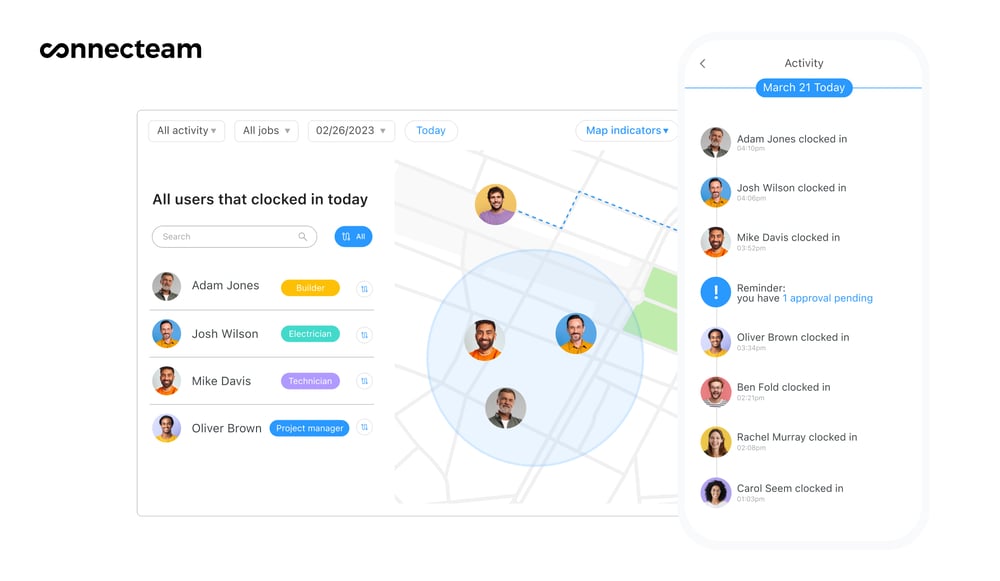Excessive overtime can burden your business and employees, leading to inefficiency and burnout. In this article, we share 7 actionable strategies to prevent overtime without compromising your team’s well-being or operational output. From establishing overtime policies to using time tracking tools, these overtime reduction strategies will teach you the best ways to reduce overtime.
Employee overtime can be a necessary evil in business. While some overtime is unavoidable, excessive amounts indicate operational problems and can negatively affect your business and employees.
Overtime creates financial strain and can lead to burnt-out employees, decreased productivity, and increased turnover.
To avoid this, you must learn how to control overtime in the workplace. Luckily, we’ve got you covered. In our guide, we share 7 proven strategies for effectively managing overtime.
Key Takeaways
- Overtime occurs due to unexpected work demands, poor planning, staff shortages, seasonal peaks, a lack of resources and tools, or overtime abuse.
- Excessive overtime affects your business and team morale, causing increased stress, turnover, and productivity loss.
- Effective ways to reduce overtime involve forecasting workloads, establishing clear overtime policies, adopting flexible schedules, cross-training employees, automating tasks, managing time, and using time-tracking tools.
- Employee management software like Connecteam can help you reduce overtime strategically.
What Causes Overtime?
Overtime occurs when an employee works hours beyond the standard 40-hour workweek. Often, employees do this to meet deadlines, handle unexpected workloads, or cover staffing shortages.
Various factors cause overtime. Unplanned work, inefficiencies, and staffing shortages can all demand more hours from your employees. Additionally, some industries are more prone to overtime, with seasonal peaks requiring more hands on deck. Deeper problems like unclear job roles or inadequate planning can also contribute to overtime.
Employees might also deliberately work overtime without approval to benefit from higher overtime rates. Workers who consistently do this are engaging in “overtime abuse.”
A worker who claims overtime they didn’t actually work is engaging in time theft. For example, some employees might clock in 15 minutes early each day without working those 15 minutes, and these extra minutes might contribute to stolen overtime.
Understanding these causes is the first step to learning how to control overtime in the workplace.
Why Are Overtime Reduction Strategies Important?
Overtime can help you meet business needs, but it has downsides.
Firstly, it’s costly. In the United States, federal law requires overtime pay to be at least 1.5 times employees’ regular rates. However, some states have overtime laws that require higher rates or have different definitions for what constitutes overtime. For example, California employers must pay employees “double time” or twice their regular rates in certain circumstances.
This Might Interest You
Read our guides on overtime laws by state, overtime guide for managers and double time vs. overtime.
The negative effects of overtime on employees are also detrimental to your business. Overworked employees often experience decreased productivity and reduced job satisfaction and suffer from health problems like increased stress, anxiety, and fatigue. Long work hours can lead to burnout, high turnover, and a toxic work culture.
Meanwhile, reducing overtime can lead to significant benefits. It can reduce labor costs, positively impact your bottom line, promote employee health and well-being, and increase productivity and work quality.
A better work-life balance also boosts employee retention and your organization’s reputation, helping attract new talent. Moreover, overtime reduction ensures compliance with legal work-hour limits and contributes to long-term sustainability by encouraging efficient planning and a more adaptable workforce.
How To Reduce Overtime Hours: 7 Proven Overtime Reduction Strategies
Curious about how to prevent overtime? Learn how to reduce labor costs and the negative effects of overtime on employees with these 7 strategies. Together, you can use these to form a solid overtime reduction action plan.
Assess workloads and overtime patterns to plan ahead
To mitigate unplanned work and reduce overtime, strategies like proactively managing workloads and setting realistic deadlines are crucial. Regularly assess your team’s workload, staffing levels, and overtime patterns.
Are certain times of the year consistently busier? Do specific projects always require extra hours? Understanding such patterns allows you to plan better by allocating resources more effectively and adjusting schedules in advance.
You should redistribute workloads evenly to ensure no single employee feels overwhelmed and prevent burnout. Consider temporary staffing to manage workload spikes without defaulting to overtime.
Overly ambitious timelines often result in unnecessary overtime. Setting realistic deadlines, being flexible, and adjusting strategies based on real-time workload assessments ensures your approach remains effective.
Maintaining regular communication with your team regarding projects and progress is also crucial. This can uncover hidden issues (like projects taking longer than projected) before they lead to overtime.
Pro Tip
Implement a “pre-overtime” check-in process where managers discuss potential overtime with employees beforehand, exploring alternatives and ensuring overtime is necessary.
Setting the ground rules with clear overtime policies
Establish a clear and comprehensive framework that guides when and how employees can use overtime. This framework helps with managing overtime through well-defined policies and specific caps.
Common policies:
- Managerial approval: Requires employees to obtain manager approval before incurring any overtime, ensuring all overtime is necessary and accounted for.
- No overtime policy: Is useful in non-critical periods or for roles where extended hours aren’t justifiable.
- Overtime rotation: Ensures all eligible employees take turns working extra hours and prevents burnout.
- Overtime for specific roles only: Makes certain positions or departments eligible for overtime based on the nature of their work and the necessity of extended hours.
Specific caps:
- Weekly hour caps: Set a maximum number of overtime hours per employee per week, preventing burnout and promoting rest.
- Project-specific caps: For projects demanding extra effort, set upfront caps on additional hours allowed to encourage better project planning.
- Annual caps: Consider setting a yearly limit on overtime hours to ensure workers aren’t consistently working extra hours throughout the year.
Make these policies clear and accessible. Include them in an employee handbook, discuss them during meetings, and reinforce them through regular training.
Leading by example is also important. Managers should respect these caps and encourage their teams to work within them.
Embracing flexible work schedules

One of the best ways to reduce overtime is to implement flexible work schedules. Since flexible scheduling can enable employees to take on more work, this must be part of a broader strategy that includes strict policy enforcement to prevent unauthorized overtime.
Allowing staff to adjust work hours can minimize the need for overtime by:
- Enabling employees to work during their most-productive hours, ensuring they complete their tasks in less time.
- Accommodating personal needs like doctor’s appointments. This way, employees are less likely to take unexpected days off, reducing the need for other employees to cover for them (and possibly accrue overtime in the process).
- Encouraging employees to manage their time more efficiently by giving them more control over their schedules.
Here are some common types of flexible schedules:
- Shift swapping: Employees can swap shifts with each other.
- Compressed workweeks: Employees can work full hours over fewer days, such as 4 10-hour days.
- Flextime: Workers choose their start and end times within a set range.
- Part-time shifts: Part-time or temporary workers can manage extra work or cover absences without risking overtime.
Did You Know?
Connecteam is a scheduling app that makes managing flexible options effortless. It allows easy shift adjustments, enables employees to swap shifts, and provides automated alerts for scheduling conflicts.
Building a versatile team with cross-training
Training employees to perform tasks and roles outside their usual responsibilities reduces your dependency on key personnel. When absences occur, or employees leave the company, you don’t have to rely on employees with specific skills or knowledge to rack up overtime hours to provide coverage. Instead, you can effectively distribute tasks amongst various cross-trained employees.
Begin cross-training by identifying essential tasks and skills within your business and determining which employees are suited to learn them. A training needs assessment involving self-evaluations, competency tests, and peer feedback can help with this.
Next, develop a cross-training plan, choosing methods that suit your team. Pairing up employees to teach each other their tasks can foster a collaborative learning work environment. Workshops and seminars provide structured learning, while online platforms offer flexible, self-paced education.
Did You Know?
Connecteam’s employee training software enables you to create tailored courses on any topic. Your employees can conveniently access them at any time from their mobile devices.
Get started with Connecteam for free today!
Empowering your business with efficiency-boosting technology
Manual and repetitive tasks can significantly drain you and your team’s productivity. Equipping your team with the right technology and tools can automate routine tasks—reducing the need for extended hours.
Start by identifying the repetitive tasks that consume a disproportionate amount of time. Are there tools to help with these? Tools like customer relationship management (CRM) systems, project management workflow software, and employee management platforms can significantly reduce time spent on repetitive activities.
For instance, a CRM system can automate customer follow-ups. Project management workflow tools can keep everyone on track with deadlines and responsibilities, preventing last-minute rushes that lead to overtime.
Additionally, consider tools that facilitate better communication and collaboration. Platforms that enable real-time sharing and editing of documents, virtual meetings, and instant messaging can cut down the time wasted on lengthy email chains and unnecessary meetings.
Did You Know?
Connecteam is an all-in-one employee management platform with various features for streamlining daily operations and automating routine tasks.
Practicing time management and accountability
Effective time management involves training employees to manage their workday better. Start by encouraging employees to prioritize tasks, set realistic deadlines, and break larger projects into manageable segments. Introduce them to effective time management techniques, including:
- Pomodoro technique: Break work into intervals (usually 25 minutes) followed by short breaks. This helps maintain focus and prevent burnout.
- Eisenhower box: Categorize tasks into four quadrants based on urgency and importance to prioritize activities and manage time.
- Time blocking: Divide the day into blocks of time dedicated to specific tasks or groups of tasks, promoting dedicated focus and structure.
For accountability, plan regular check-ins where employees report on their progress and discuss time management challenges.
Did You Know?
With Connecteam’s team instant messaging, checking in with employees is easy. Instantly communicate with employees privately or in groups. You can even post company-wide updates.
Use a time-tracking tool to track and restrict overtime
Using time-tracking tools can help you audit your employees’ time use by providing insights into work patterns and highlighting areas where employees could use time more effectively.
This information can help you determine how to prevent overtime. For example, say employees aren’t using the last hours of each workday effectively and putting in extra hours over the weekend to meet deadlines. Knowing this can help you come up with a solution (like offering flextime).
Further, many time-tracking tools empower managers to restrict overtime in several ways:
- Custom overtime rules: Set up rules to automatically manage and restrict unauthorized overtime.
- Automated alerts: Receive notifications as employees approach overtime limits.
- Real-time visibility: Monitor work hours in real-time to prevent excessive overtime and ensure equitable workload distribution.

Before implementing any tool, ensure employees understand the reasons for monitoring overtime and train them to record their hours correctly.
Stay on Top of Employee Overtime With Connecteam
Connecteam is an all-in-one workforce management platform with all the tools you need to manage and reduce overtime effectively. The platform has a powerful employee time clock that accurately tracks your employees’ worked hours, including overtime.
Connecteam’s overtime tracking lets you customize your overtime rules and rates according to your company policies and state laws. This ensures you don’t pay for unwanted overtime—plus, it helps you stay compliant with overtime regulations when overtime is necessary. The app automatically calculates overtime pay using error-free timesheets for payroll.
The overtime app also prevents unauthorized overtime by letting you establish daily and weekly overtime thresholds. The system alerts you when employees are nearing overtime thresholds, enabling proactive management and timely intervention. It can even automatically clock out employees who go into unapproved overtime.

You can restrict employees from clocking in early or clocking out late and automatically track paid and unpaid breaks to prevent overtime-related time theft. Connecteam’s real-time GPS tracker with its geofence time clock can even set a virtual boundary around workplaces, preventing employees from clocking in or out when offsite.
Connecteam offers various other features beyond overtime management, including scheduling, task management, training, and communication features. Moreover, Connecteam provides custom reports on productivity and expenses related to specific tasks and projects, offering insights to inform your overtime reduction action plan.
Final Thoughts on Strategically Reducing Overtime
Many employers wonder how to prevent overtime, as excessive overtime can be costly. And the effects of overtime on employees are harmful to employees and businesses.
The best ways to reduce overtime include proactively assessing workloads, setting clear overtime policies, embracing flexibility, cross-training, leveraging technology, practicing time management, and using time-tracking tools. With these overtime reduction strategies, you can start effectively managing overtime and creating a more efficient workforce.
Tools like Connecteam can prove invaluable to your overtime reduction action plan. It gives you everything you need to implement these strategies.
FAQs
How can you reduce overtime in manufacturing?
To reduce overtime in manufacturing, streamline workloads with smart scheduling and cross-trained staff. Implement lean manufacturing principles, improve production planning, automate repetitive tasks, and nurture a culture that values work-life balance.
Are employers required to pay for unauthorized overtime?
Yes. Under the Fair Labor Standards Act (FLSA) in the US, employers must pay covered employees overtime, even when it’s unauthorized. Exceptions apply to certain roles, and state laws may vary. Employers are responsible for preventing unauthorized overtime through clear policies and monitoring.

